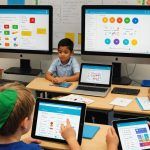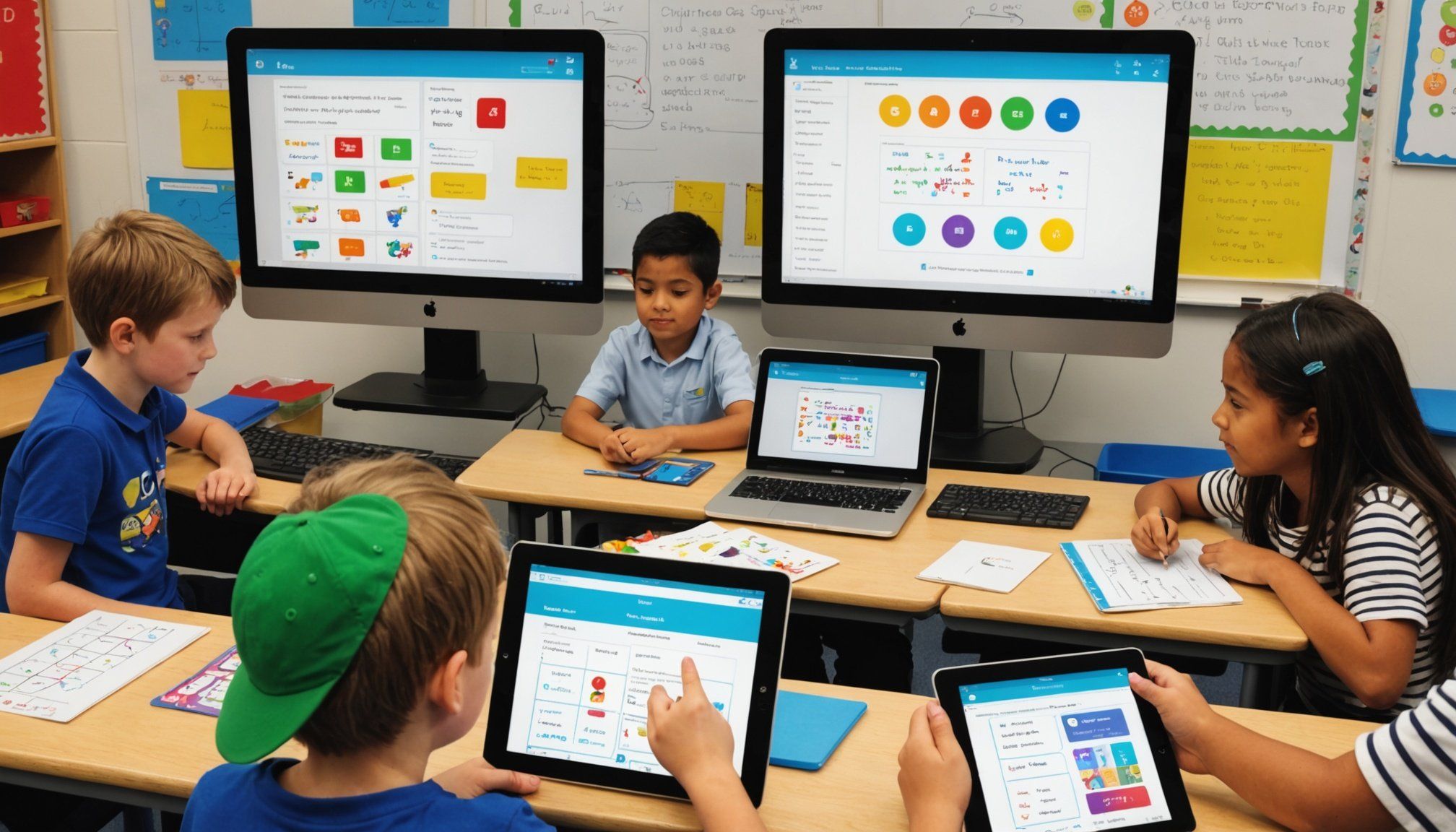Creating Engaging Math Apps for Primary Students in UK Classrooms
In the modern educational landscape, technology has become an indispensable tool for teaching and learning, especially when it comes to subjects like mathematics. Math apps have revolutionized the way primary school students in the UK engage with math, making it more enjoyable, interactive, and effective. Here’s a comprehensive look at how these apps are transforming math education.
The Importance of Engaging Math Apps
Mathematics is a fundamental subject that builds critical thinking skills, enhances problem-solving abilities, and is essential for various fields, including science, engineering, and technology. However, math can often feel abstract and disconnected from daily life, especially for young students. This is where engaging math apps come into play.
Also read : Mastering Remote Work Policies for UK Firms: An In-Depth Blueprint for Success
“Mathematics is everywhere, and by using interactive tools, we can make it feel more relevant and fun for children,” says a Specialist IGCSE Maths Teacher at Sophia High School[3].
Key Features of Effective Math Apps
To be truly effective, math apps for primary students need to incorporate several key features:
Also read : Revolutionizing Personalized Nutrition: AI Strategies for UK Health Tech Trailblazers
Interactive Learning Platforms and Gamification
One of the most effective ways to engage students in math is through gamification. Apps like Prodigy and Sumdog turn math practice into an enjoyable, competition-based activity. These platforms offer interactive problems, levels to conquer, and rewards for success, which can be highly motivating for students.
- Prodigy: This app adapts to each student’s skill level, ensuring that the challenges are always appropriate to their learning pace. With its fantasy adventure theme, Prodigy makes learning math exciting for younger audiences[3].
- Sumdog: Sumdog combines math practice with games, allowing students to compete against others or practice at their own pace. The platform provides personalized learning, helping students master essential skills from basic arithmetic to advanced concepts like algebra and geometry[3].
Real-World Connections
Connecting math to real-world applications is crucial for making the subject more relatable and interesting.
- Project-based Learning: Apps can incorporate project-based learning where students use math to solve real-world problems. For example, designing a small building using geometric principles or analyzing the best value for products using ratios and percentages[3].
- Guest Sessions: Virtual guest sessions with professionals who use math in their daily work, such as engineers or data scientists, can demonstrate the practical application of mathematical concepts.
Visual Tools for Mathematical Thinking
Visual tools can help students make sense of complex math problems by turning them into images or graphs.
- GeoGebra: This dynamic mathematics software allows students to explore geometry, algebra, calculus, and statistics interactively. GeoGebra provides both visualizations and simulations to help students see mathematical concepts come to life[3].
- Desmos: Desmos offers a free graphing calculator and interactive tools for exploring functions, graphs, and other mathematical concepts. It allows students to visually manipulate graphs and explore mathematical relationships in real-time[3].
Examples of Engaging Math Apps
Here are some examples of math apps that are making a significant impact in UK primary school classrooms:
Sparx Maths
Sparx Maths is an online learning platform that personalizes each child’s homework, creating a weekly set of questions tailored to their level of understanding and learning pace. The questions are designed to be achievable while offering the stretch that learners need to make progress. This app ensures that students practice skills from previous topics, reinforcing their learning continuously[1].
Supermaths
Supermaths uses the abacus method to make math learning fun and easy. The app includes interactive games and classes that help children develop their problem-solving skills, concentration, and confidence. With the help of AI homework assistant Olivia, Supermaths provides instant, expert-level guidance around the clock, adapting to each student’s unique learning style[2].
Mathsframe
Mathsframe offers over 200 interactive math games and 300 math worksheets and assessments linked to the new curriculum. Designed by a teacher for teachers, these resources cover a wide range of topics from addition and subtraction to fractions, decimals, and percentages. The app is particularly useful for small group work and individual practice[4].
Strategies for Teachers to Use Math Apps Effectively
To maximize the benefits of math apps, teachers need to integrate them thoughtfully into their teaching strategies.
Incorporating Apps into Lesson Plans
Teachers can use apps as a supplement to traditional teaching methods. For example, using an app like Prodigy for homework or as a warm-up activity before a lesson.
Small Group Work
Apps like Mathsframe can be used in small group settings, allowing students to work together on math problems and games. This fosters collaboration and peer-to-peer learning.
Real-Time Feedback
Apps that provide real-time feedback, such as Supermaths with its AI assistant Olivia, can help teachers monitor student progress and adjust their teaching accordingly.
Benefits of Using Math Apps in Education
The use of math apps in primary school education offers several benefits:
Enhanced Engagement
Math apps make learning math more enjoyable and interactive, which can significantly boost student engagement.
Personalized Learning
Apps like Sparx Maths and Supermaths offer personalized learning paths, ensuring that each child is challenged at their appropriate level.
Improved Math Skills
Regular practice through apps can lead to significant learning gains in math skills, including problem-solving, addition, subtraction, and times tables.
Confidence Building
Interactive and rewarding experiences provided by these apps can help build confidence in children, making them more enthusiastic about learning math.
Practical Insights and Actionable Advice
Here are some practical tips for teachers and parents to make the most out of math apps:
- Choose Apps Aligned with Curriculum: Ensure that the apps you choose align with the national curriculum to reinforce classroom learning.
- Monitor Progress: Use the feedback features of the apps to monitor student progress and adjust teaching strategies accordingly.
- Encourage Consistent Practice: Encourage children to use the apps regularly, even if it’s just for a few minutes each day.
- Make it Fun: Use the gamification features of apps to make math practice feel like play.
Table: Comparison of Popular Math Apps
| App Name | Key Features | Age Group | Platform | Cost |
|---|---|---|---|---|
| Sparx Maths | Personalized homework, practice from previous topics | Primary school | Web, Mobile | Subscription |
| Supermaths | Abacus method, AI homework assistant, interactive games | Primary school | Web, Mobile | Subscription |
| Mathsframe | Interactive games, worksheets, assessments linked to curriculum | Primary school | Web, Mobile | Free, Premium |
| Prodigy | Gamification, fantasy adventure theme, adaptive learning | Primary school | Web, Mobile | Free, Premium |
| Sumdog | Math games, competitions, personalized learning | Primary school | Web, Mobile | Free, Premium |
Quotes from Teachers and Parents
- “Using Sparx Maths has significantly improved the engagement of our students in math homework. The personalized approach ensures that each child is challenged appropriately,” says a teacher from Ellis Guilford School[1].
- “Supermaths has been a game-changer for my child. The abacus method and the AI assistant have made math learning fun and easy,” says a parent whose child uses Supermaths[2].
- “Mathsframe has been incredibly useful for our small group work. The interactive games and worksheets are perfect for reinforcing classroom learning,” says a teacher who uses Mathsframe[4].: Inspiring a Love for Math
Engaging math apps are not just tools; they are gateways to a world where math is fun, interactive, and deeply connected to real-life scenarios. By leveraging these apps, educators and parents can inspire a lasting love for math in children, helping them develop the critical thinking skills and confidence they need to succeed in both academic and real-life scenarios.
In conclusion, creating engaging math apps for primary students is about more than just technology; it’s about crafting an educational experience that is both enjoyable and effective. With the right tools and strategies, we can ensure that the next generation of learners not only understands math but also loves it.









